
As Arsenal manager Arsene Wenger once said: “Food is like kerosene. If you put the wrong one in your car, it’s not as quick as it should be”. If you want to play like a star, you have to eat like one too. Diet is a huge part of performing at your best – so take a tip from the pros and eat like an athlete!
Balance is crucial, too much of anything can knock you off-course, and too little can be even worse. It’s estimated that carbohydrates make up 60-70% of a premier league player’s diet, but the carbs you choose make a big difference.
Matt Lovell, expert sports nutritionist recommends a serving of fruit before a big match, “mangos, papaya, pineapples, bananas – are all good at this stage because they’ve got modest amounts of fibre and don’t give as much of a sugar rush as other fruits,” which means your energy lasts from kick off to the final whistle, without a sugar crash at half time.
These fruits contain complex carbohydrates, the key ingredient for long lasting energy. Whole-grain bread, starchy veg like potatoes and beans are also complex carbs – but not all carbs are equal, simple carbohydrates such as sugary foods or white bread for example, will release a short burst of energy without the slow burn factor or nutrients contained in complex carb foods.
‘Bananas are easy to peel and eat, they taste great and give you a real energy boost before the game!’
There are loads of ways to keep your body well fueled, so keep checking this page for ideas and recipes.


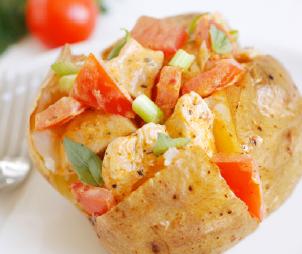
Chicken & tomato jackets
with Greek yoghurt
A simple jacket potato recipe, with a creamy and flavoursome filling. Baked potatoes can be cooked in the oven, or in the microwave to save time.
Serves: 4 adults
Preparation time: 5 mins
Cooking time: 25 mins
Ingredients:
4 baking potatoes (each needs to be around 225g)
4 skinless, boneless uncooked chicken breasts
1 tsp dried oregano
8 tomatoes (ripe is best)
150g low fat Greek-style natural yoghurt
4 spring onions finely chopped
1 tsp red pesto (optional)
What to do:
1. Scrub the potatoes, then dry and prick each one several times with a sharp knife.
2. Microwave Method: Cook one potato (225g/8oz) for 6 minutes on full power (800W), turn halfway
through cooking. Allow to stand for 1-2 minutes before serving. If cooking more than one potato at a time
you need to increase the cooking time accordingly.
3. Oven Method: Rub a few drops of olive oil into the potato skin, place the potatoes in a pre-heated oven
at 200°C, 400°F, Gas Mark 6 on a baking. Bake for 1¼ hours or until soft.
4. When the potatoes are almost ready, cut the chicken breasts into bite-size chunks, heat a non-stick
frying pan and pan fry until lightly browned on both sides and cooked through for about about 6-8 mins. Add
a pinch of dried oregano, rosemary or basil per person.
5. Meanwhile, chop the tomatoes into chunks, discarding the seeds. When the chicken is cooked, stir
together the chicken, tomato, spring onions and the pot of yoghurt. Add pesto if you wish.
6. Serve the jacket potatoes with a portion of the chicken mixture and enjoy.
Tip 1: King Edward or Maris Piper potatoes would work best for this recipe.
Tip 2: If you don’t have dried oregano, rosemary or basil would also work well.
Nutritional information:
Per portion (i.e. ¼ recipe)
352.6kcal/1475kJ
2.4g fat
0.7g saturates
0.0g salt
5.5g sugar
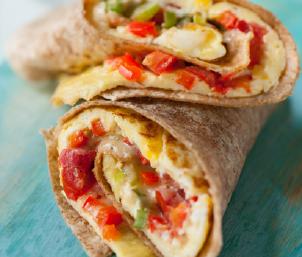
Breakfast burritos
Wholewheat soft tortillas are topped with tomato and pepper omelettes, then rolled up. Perfect for a tasty breakfast or wrap up for a packed lunch.
Serves: 4 adults
Preparation time: 10 mins
Cooking time: 10 mins
Ingredients:
4 soft wholewheat flour tortillas
6 eggs
4 tbsp 1% fat milk
2 tomatoes finely chopped
2 spring onions finely chopped
1 peppers, any colour deseeded and finely chopped
2 tsp vegetable oil
40g reduced fat hard cheese grated
1 pinch ground black pepper
What to do:
1. Lay out the tortillas on a work surface. Preheat the grill.
2. Beat the eggs and milk together. In a separate bowl, mix together the tomatoes, spring onions and pepper, seasoning with black pepper.
3. Heat ½ tsp of vegetable oil in a non-stick frying pan and pour in one quarter of the beaten egg mixture. Cook on the hob over a medium heat for a few moments to set the base.
Sprinkle one quarter of the tomato mixture over the surface, then sprinkle 10g of the cheese over the top. Grill to set the egg and melt the cheese.
4. Slide the omelette onto one of the tortillas. Leave to cool a little while you make three more omelettes, placing them on top of the tortillas as you go.
5. Roll up the tortillas, slice in half and serve immediately, or wrap in foil to serve later.
Tip 1: Just top the omelettes with tomatoes and reduced fat cheese, or swap the suggested vegetables for
your favourite combination.
Tip 2: You could use plain tortillas, though the wholewheat ones have a higher fibre content.
Tip 3: To make the burritos more filling, try adding 100g drained mixed beans to the tomato mixture – you’ll
be adding extra fibre too.
Nutritional information:
Per adult portion (i.e. ¼ recipe)
229kcal/958kJ
15g protein
17g carbohydrate of which 5g sugars
12g fat of which 4g saturates
1.5g fibre
240mg sodium equivalent to 0.6g salt
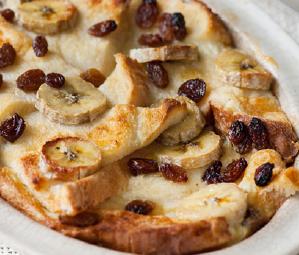
Banana & sultana bread & butter pudding
Try this delicious variation of a firm family favourite.
Serves: 4 adults
Preparation time: 15 mins
Cooking time: 30 mins
Ingredients:
25g low-fat spread
4 slices white bread
2 bananas sliced
25g sultanas
2 eggs
450ml 1% fat milk
1 tsp vanilla extract (optional)
10g caster sugar
What to do:
1. Preheat the oven to Gas Mark 4/180°C/ fan oven 160°C.
2. Grease a 1.2 litre (2 pint) baking dish with a little reduced fat spread. Spread the rest over the bread, then cut each slice into four triangles. Arrange them in the dish with the sliced bananas and sultanas or raisins.
3. Beat together the eggs, milk and vanilla extract. Stir in the sugar and allow a few minutes for it to dissolve. Pour the mixture over the bread, and let it soak in for 5 minutes.
4. Bake on the middle shelf of the oven for about 25-30 minutes, until set and golden brown.
Tip 1: This recipe is perfect for using up bread that is 2-3 days old. Its drier texture soaks up more of the egg and milk mixture to make it light and puffy.
Tip 2: You could use fruit bread in this recipe, and omit the sultanas or raisins. The slices may be smaller, so you could use and extra piece.
Tip 3: If you like, use chopped ready-to-eat dried apricots or dates instead of sultan
as or raisins.
Nutritional information:
Per portion (1/4 recipe)
270kcal/1130kJ
11g protein
41g carbohydrate of which 25g sugars
8g fat of which 3g saturates
1g fibre
282mg sodium equivalent to 0.7g salt
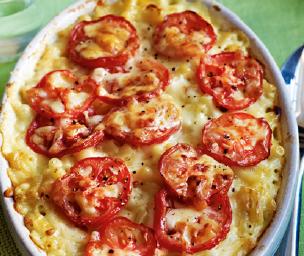
Baked macaroni cheese with tomatoes
This recipe turns what is often a high-fat family favourite into a healthier option for everyone.
Serves: 4 adults
Preparation time: 15 mins
Cooking time: 35 mins
Ingredients:
300g macaroni
50g low-fat spread
1 small onion finely chopped
50g plain flour
600ml semi-skimmed milk
100g reduced fat mature Cheddar cheese grated
1 tsp English mustard
1 pinch ground black pepper
2 tomatoes sliced
What to do:
1. Preheat the oven to 190°, fan 170°C, gas mark 5.
2. Cook the macaroni in a large saucepan of boiling water for 8-10 minutes, or according to the instructions on the packet, until tender.
3. Meanwhile, melt the low-fat spread in a large saucepan and cook the onion for 3-4 minutes until softened, but not brown. Remove from the heat and stir in the flour. Return to the heat and cook gently for about 1 minute, stirring, until the mixture has a texture like sand.
4. Remove from the heat and add the milk a little at a time, stirring well to mix together. Then return to the heat, stirring all the time, until the sauce is thick and smooth. At this point, remove from the heat and add about two-thirds of the cheese and the mustard. Season with pepper.
5. Drain the cooked pasta well and return it to the saucepan. Stir in the hot cheese sauce. Tip the mixture into a baking dish which can hold about 1.2 litres, or use individual serving dishes. Top with the sliced tomatoes and sprinkle the left-over cheese on top. Bake for 15-20 minutes, until piping hot, then serve.
Tip 1: Use tubes of pasta instead of macaroni. Take care not to overcook it – it needs to keep a little ‘bite’.
Tip 2: Instead of tomatoes you could use a layer of sliced leeks, courgettes and peppers, lightly cooked in boiling water to soften them.
Nutritional information:
Per adult portion (i.e. 1/4 recipe)
502kcals/2098kJ
25g protein
13g fat of which 4g saturates
76.5carbohydrate of which 12g sugars
3g dietary fibre
330mg sodium
0.8gsalt
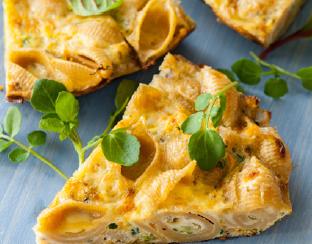
This recipe is so tasty! It is perfect served cold packed in lunches, though it tastes equally good served warm with vegetables or salad.
Serves: 4 adults
Preparation time: 15 mins
Cooking time: 30 mins
Ingredients:
100g pasta shapes
1 tsp vegetable oil
1 small onion chopped
2 courgettes grated
2 carrots grated
4 eggs
50g reduced fat hard cheese grated
2 tsp dried mixed herbs
1 pinch ground black pepper
What to do:
1. Cook the pasta shapes in boiling water for 10-12 minutes, until just tender. Drain thoroughly and rinse with cold water to cool them quickly.
2. Heat the vegetable oil in a non-stick frying pan and gently cook the onion for 3-4 minutes, stirring often. Remove from the heat and add the courgettes, carrots and pasta, mixing well.
3. Beat the eggs and add the cheese. Stir in the dried herbs and season with some pepper. Pour into the frying pan and cook over a low heat for 4-5 minutes, without stirring, to set the base. Meanwhile, preheat the grill to medium-high.
4. Put the frying pan under the grill and cook for 4-5 minutes until the surface has set and is golden brown. Cool completely if serving for a packed lunch. Cut into wedges and wrap in cling film or greaseproof paper and chill until needed.
Tip 1: When taking packed lunches to school or work, try to use an insulated container and include a small
ice pack to keep things cool and fresh.
Tip 2: You could use cooked potatoes instead of pasta. You will need about 300g altogether, chopped into chunks.
Nutritional information:
Per portion (i.e. ¼ recipe)
284kcal/1188kJ
18g protein
30g carbohydrate of which 11g sugars
11g fat of which 3g saturates
4g fibre
200mg sodium equivalent to 0.5g salt
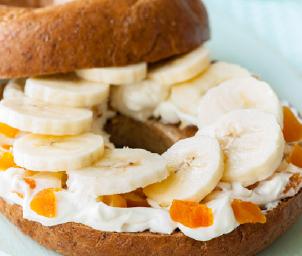
Banana & apricot bagels
Such a simple idea – yet these fruity bagels taste so good!
Serves: 4 adults
Preparation time: 10 mins
Cooking time: 2 mins
Ingredients:
4 wholemeal bagels sliced in half
80g lower fat soft cheese
40g ready-to-eat apricots chopped
2 bananas
What to do:
1. Preheat the grill. Lightly toast the cut sides of each bagel.
2. Mix the reduced fat soft cheese and apricots together and spread over the bagel bases. Top with sliced banana and sandwich the bagel tops in place.
Tip 1: Try using sesame and poppy seed bagels for a change.
Tip 2: If you can’t eat dairy products, omit the soft cheese. Mash the banana and spread over the toasted bagel, then sprinkle the chopped apricots on top.
Tip 3: If you like, sprinkle the banana with lemon juice or a pinch of nutmeg for extra flavour.
Nutritional information:
Per adult portion (i.e. per bagel)
244kcal/1020kJ
11.5g protein
46g carbohydrate of which 18g sugars
2g fat of which 1g saturates
5g fibre
270mg sodium equivalent to 0.7g salt
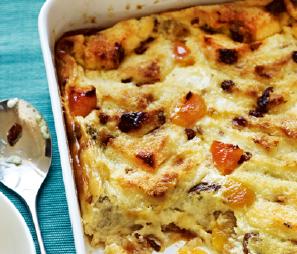
Apricot bread pudding
Here’s a delicious version of bread and butter pudding, which is quick and easy to make. It’s an ideal way to use up slightly stale bread.
Serves: 4 adults
Preparation time: 15 mins
Cooking time: 35 mins
Ingredients:
25g low-fat spread
6 slices sliced fruit bread
50g ready-to-eat apricots chopped
2 eggs
450ml semi-skimmed milk
1 tsp vanilla extract (optional)
45g caster sugar
What to do:
1. Grease a 1 litre baking dish with ½ teaspoon of the low-fat spread. Spread the bread with the rest of the low-fat spread, then cut each slice into triangles. Arrange them in the dish with the chopped apricots.
2. Beat together the eggs, milk and vanilla extract. Stir in the sugar, allowing a few minutes for it to dissolve. Pour over the bread. Cover and leave to soak for at least 20 minutes.
3. Preheat the oven to 180°C, fan 160°C, gas mark 4. Uncover the pudding and bake for about 35-40 minutes, until set and golden brown.
Tip 1: If you like, prepare the pudding in advance and keep in the fridge so that it can soak for several hours before baking.
Tip 2: Use ordinary white bread instead of fruit bread and add a handful of sultanas and dried cherries or cranberries to the pudding.
Nutritional information:
Per adult portion (i.e. ¼ recipe)
295 kcals/1233kJ
12g protein
8.5g fat, of which 3g saturates
46g carbohydrate, of which 29g sugars
1.5g dietary fibre
330mg sodium
0.8g salts
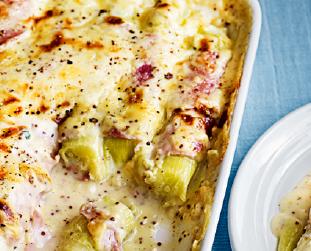
Baked leeks & ham in cheese sauce
Enjoy this quick and easy light meal. It’s low-cost and very good for you.
Serves: 4 adults
Preparation time: 15 mins
Cooking time: 35 mins
Ingredients:
6 leeks trimmed and washed well
180g sliced wafer thin ham
35g plain flour
20g low-fat spread
300ml semi-skimmed milk
75g reduced fat mature Cheddar cheese grated
1 tsp wholegrain mustard
1 pinch ground black pepper
What to do:
1. Cook the leeks in a large saucepan of simmering water for about 10-12 minutes, until just tender. Drain well in a colander – it helps if you leave them for a few minutes to cool slightly too.
2. Wrap a slice of ham around each leek, then arrange them in a large shallow baking dish.
3. Preheat the oven to 200°C, fan 180°C, gas mark 6.
4. Put the flour, low-fat spread and milk into a non-stick saucepan. Heat, stirring all the time with a small whisk (see tip), until the sauce is thick and smooth. Cook gently for a few seconds, then remove from the heat.
5. Add all but 1 tablespoon of the cheese and stir in the mustard. Season with some pepper. Stir the sauce until the cheese has melted, then pour it over the leeks. Sprinkle the left over cheese over the top.
6. Bake in the oven for 15-20 minutes, until the leeks are heated through and the top is golden brown. Serve 2 leeks to each adult and 1 to each child.
Tip 1: It’s a good idea to invest in a small whisk coated in silicone to help make easy all-in-one sauces. They can be used in non-stick pans without scratching the surface, and they help to give a smooth, lump-free sauce.
Tip 2: If you like, arrange some sliced tomatoes on top of the leeks and sauce, then sprinkle the reserved cheese over them before baking
Nutritional information:
Per adult portion (i.e. ¼ recipe)
256 kcals/1070kJ
20g protein
13g fat, of which 6g saturates
15g carbohydrate, of which 7g sugars
4g dietary fibre
687mg sodium
1.6g salt
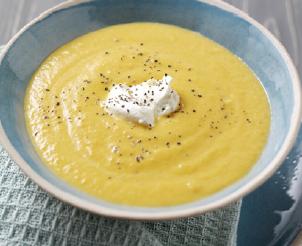
This soup is so easy to make, with just four simple ingredients and three easy steps. Serve with a slice of wholemeal bread.
Serves: 4 adults
Cooking time: 25 minsPreparation time: 15 mins
Ingredients:
1 large onion chopped
8 carrots (or 500g), chopped
1.2 litres reduced salt vegetable or chicken stock
100g lower fat soft cheese
1 pinch ground black pepper
What to do:
1. Put the onion and carrots into a large saucepan with the reduced salt stock.
2. Bring up to the boil, then reduce the heat and simmer, partially covered, for 20-25 minutes, or until the vegetables are tender.
3. Blend the soup to a puree using a handheld stick blender, or transfer to a food processor or blender and whizz until smooth. Add most of the soft cheese and blend again until it is thoroughly mixed in. Reheat gently, then serve, garnished with the remaining cheese and a little black pepper. Enjoy with a slice of wholemeal bread.
Tip 1: Cover, cool and refrigerate the soup, using it within 3 days of making it, and reheating it thoroughly when ready to serve.
Tip 2: As an alternative to carrots, have a go at using 500g of chopped butternut squash instead – it has a lovely flavour and is well worth trying. To prepare it, first you’ll need to peel it and scoop out the seeds before chopping into chunks.
Nutritional information:
Per portion (i.e. ¼ recipe)
103kcals / 431 kJ
5.5g protein
3g fat of which 1.4g saturates
16g carbohydrate of which 13.5g sugars
4g dietary fibre
428mg sodium
1g salt
Suitable for freezing

Baked tomatoes on toast
You won’t be able to resist the delicious aroma of these herby baked tomatoes!
Serves: 4 adults
Preparation time: 5 mins
Cooking time: 15 mins
Ingredients:
8 tomatoes halved
3 handfuls cherry tomatoes halved
1 tsp dried mixed herbs
2 tsp fresh chives chopped (optional)
2 tbsp white or wholemeal breadcrumbs (dried not fresh)
4 tsp parmesan cheese finely grated
4 slices wholemeal bread
1 pinch ground black pepper
What to do:
1. Preheat the oven to Gas Mark 5/190°C/fan oven 170°C.
2. Arrange the tomatoes, cut sides up, on a baking sheet. Sprinkle with the dried herbs and chives (if using) and season with black pepper. Roast for 10 minutes, then sprinkle the breadcrumbs and Parmesan cheese over them. Roast for 5 more minutes.
3. Meanwhile, toast the slices of bread.
4. Place the toast on warmed plates and share the tomatoes between them. Sprinkle with a little extra black pepper, then serve.
Tip 1: This is a great recipe to make when tomatoes are in season, or if you grow your own.
Tip 2: If you’re vegetarian, make sure that you choose a vegetarian version of Parmesan cheese.
Tip 3: For a change, stuff the baked tomatoes into warmed wholemeal pittas.
Nutritional information:
Per portion (i.e. ¼ recipe)
212kcal/887kJ
10g protein
33.5g carbohydrate of which 9g sugars
5g fat of which 2g saturates
353mg sodium equivalent to 0.8g salt
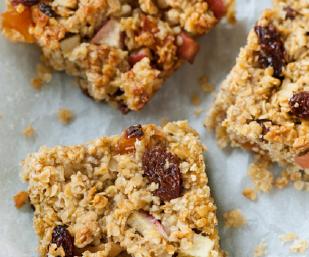
Apple, apricot & sultana squares
The perfect treat with a cup of tea. And great for packed lunches and picnics too!
Serves: 16 adults
Preparation time: 15 mins
Cooking time: 20 mins
Ingredients:
100g low-fat spread
4 tbsp golden syrup
250g porridge oats
1 apple cored and chopped
50g ready-to-eat apricots chopped
50g sultanas
½ tsp ground mixed spice (optional)
1 egg beaten
What to do:
1. Preheat the oven to Gas Mark 4/180°C/ fan oven 160°C. Grease a 23cm (9inch) shallow square cake tin with a little reduced fat spread, then line the base with baking parchment or greaseproof paper
2. Melt the remaining reduced fat spread in a large saucepan with the golden syrup. Take care that the mixture doesn’t get too hot.
3. Remove the pan from the heat and add the porridge oats, apple, apricots, sultanas or raisins and mixed spice (if using). Stir well, add the beaten egg and mix again.
4. Tip the mixture into the prepared tin and level the surface. Bake for 20-25 minutes until firm. Cool in the tin for about 20 minutes, then cut into 16 squares.
Tip 1: Store in an airtight tin, or pack in freezer wrap or a freezer box and freeze for up to 3 months.
Tip 2: If you like, melt the reduced fat spread and golden syrup in a large microwaveable bowl for 40-50 seconds on HIGH, then add the remaining ingredients as above.
Tip 3: Choose high fibre porridge oats to provide extra fibre in your diet.
Nutritional information:
Per adult portion (i.e. ¼ recipe)
121kcal/506kJ
2.5g protein
19g carbohydrate of which 9g sugars
2.5g fat of which 1.2g saturates
1.5g fibre
50mg sodium equivalent to 0.1g salt
suitable for freezing
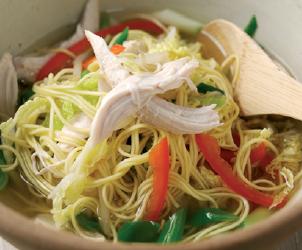
10 Minute chicken noodle soup
This is such a versatile dish – it’s ideal for using up leftover veg and you can use any type of meat. An almost instant meal in a bowl!
Preparation time: 3 mins
Cooking time: 7 mins
Ingredients:
125g medium or fine dried egg noodles
1.2 litres reduced salt vegetable or chicken stock
300g frozen or fresh stir-fry vegetables
250g skinless, boneless roast chicken breasts sliced
1 pinch ground black pepper
1 tbsp reduced salt soy sauce
What to do:
1. Put the noodles into a heatproof bowl and cover them with boiling water. Leave to soak for 6 minutes.
2. Meanwhile, pour the stock into a large saucepan and bring up to the boil. Add the vegetables and simmer for 5 minutes.
3. Drain the noodles, then add them to the saucepan with the sliced chicken. Season with pepper. Heat for 1-2 minutes, then ladle into bowls.
4. Serve each portion sprinkled with a few drops of soy sauce.
Tip 1: This is a great way to make the most of any fresh vegetables that need to be used up.
Tip 2: If you like things spicy, add a few fine slices of fresh red or green chilli, or a pinch of dried chilli flakes.
Nutritional information:
Per portion (i.e. ¼ recipe)
245kcals / 1025kJ
26g protein
4g fat of which 1g saturates
26g carbohydrate of which 4g sugars
3g dietary fibre
215mg sodium
0.5g salt
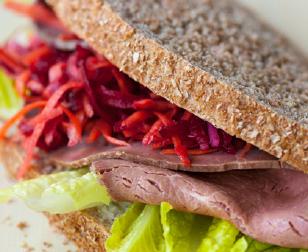
Beefed up Sarnies
Add a colourful grated salad to a roast beef sandwich to provide extra fibre and vitamins to your diet.
Serves: 4 adults
Preparation time: 15 mins
Cooking time: 0 mins
Ingredients:
1 carrot grated
1 cooked beetroot (vacuum packed) grated
½ small red onion thinly sliced
2 tsp vinegar
8 slices wholemeal bread
8 tsp reduced fat mayonnaise
1 handful mixed salad leaves
4 slices lean roast beef (fat trimmed off)
1 pinch ground black pepper
What to do:
1. In a bowl, mix together the carrot, beetroot and red onion with the vinegar. Season with black pepper.
2. Spread each slice of bread with 1 tsp mayonnaise, then top 4 of them with the lettuce leaves and the roast beef. Share the salad between them, then sandwich together with the remaining slices of bread. Cut in half and serve at once, or wrap and keep cool to serve later.
Tip 1: Another time, use lean roast pork or ham instead of beef.
Tip 2: For a vegetarian version, omit the beef and the mayonnaise, and use 80g of reduced fat hummus for spreading onto the slices of bread.
Tip 3: Use a couple of finely sliced spring onions instead of red onion, if you prefer.
Nutritional information:
Per adult portion (i.e. ¼ recipe)
263kcal/1100kJ
18g protein
35g carbohydrate of which 6g sugars
6.5g fat of which 1g saturates
4g fibre
478mg sodium equivalent to 1.1g salt
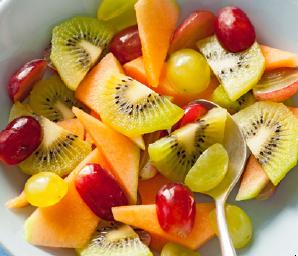
A Fresh ‘n’ fruity start
This refreshing fruit salad is a perfect way to enjoy fruit as part of breakfast, and add towards your 5 A DAY target for fruit and vegetables.
Serves: 4 adults
Preparation time: 15 mins
Cooking time: 0 mins
Ingredients:
200g red or green seedless grapes halved4 kiwi fruit peeled and sliced
½ melon, Cantaloupe or Galia peeled, deseeded and chopped
8 tbsp low-fat natural yoghurt
1 pinch ground ginger (optional)
What to do:
1. In a fruit bowl, mix together the sliced kiwi fruit, grapes and melon.
2. Mix together the low fat yoghurt and ginger (if using). Share the fruit between four serving bowls and spoon the yoghurt mixture on top.
Tip 1: Try to eat a fruit salad with breakfast at least once a week, varying the fruit as you wish. Try these different combinations: oranges, raspberries and blueberries; apple, mango and pomegranate seeds; pears, blackberries and sliced peach or nectarine.
Tip 2: Remember, if you choose canned fruit, make sure that it’s packed in natural fruit juice, not syrup.
Tip 3: If you prefer not to eat dairy products, choose a soya-based yoghurt instead.
Nutritional information:
Per adult portion (i.e. ¼ recipe)
117kcal/490 kJ
6g protein
23g carbohydrate of which 22g sugars
1g fat of which 0.5g saturates
1g fibre
65mg sodium equivalent to 0.2g salt
 | 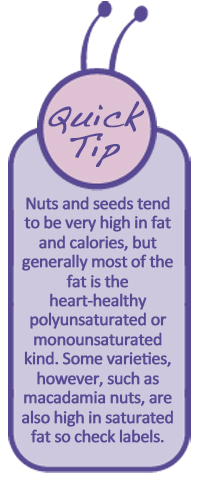 | ||||
AVACADO for | 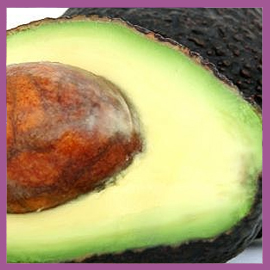 |  | |||
| We need good fats. They contain Vitamin E and they also provide a fullness that can prevent bingeing. Having avocado on a sandwich instead of mayonnaise is a wonderful surprise. It has that rich, creamy texture and flavor and it’s not an empty calorie. | |||||
Good Nutrition for Children
Nutrition guidelines recommended for adults are inappropriate for most children under the age of five. This is because young children only have small tummies and so need plenty of calories and nutrients in a small amount of food to ensure they grow properly.
While low-fat diets are recommended for older children and adults, under-fives need diets that contain good amounts of fat.
This fat should come from foods that contain plenty of other nutrients like meat, oily fish and full-fat milk (semi-skimmed milk is unsuitable for children under the age of two, and skimmed unsuitable for under-fives), rather than from high-fat foods that contain few vitamins and minerals like cakes, biscuits and chocolate.
Meanwhile, young children shouldn’t eat too many fibre-rich foods, either, as these may fill them up so much they can’t eat enough to provide them with adequate calories and nutrients.
However, as kids approach school age, they should gradually move towards a diet that’s lower in fat and higher in fibre. And by the age of five, their diet should be low in fat, sugar and salt and high in fibre with five fruit and veg a day – just like adults.
Fortunately, whatever their age, children can easily get a balanced diet – and lower their risk of becoming overweight or obese – by eating a variety of foods from four main food groups:
- Bread, other cereals and potatoes – these starchy foods, which also include pasta and rice, provide energy, fibre, vitamins and minerals
- Fruit and vegetables – these provide fibre, vitamins and minerals and are a source of antioxidants.
- Milk and dairy foods – these provide calcium for healthy bones and teeth, protein for growth, plus vitamins and minerals.
- Meat, fish and alternatives – these foods, which include eggs and pulses, provide protein and vitamins and minerals, especially iron. Pulses also contain fibre.
In contrast, foods from a fifth food group that includes fatty and sugary foods like biscuits, cakes, fizzy drinks, chocolate, sweets, crisps and pastries, that add little nutritional value, should be limited.
Children’s Vitamin and Mineral Intake
Choosing foods from each of the four main food groups will help to ensure that kids receive all the vitamins and minerals they need for good nutrition and health.
Worryingly, figures from the National Diet and Nutrition Survey of Young People reveals that many children have inadequate intakes of many nutrients, including vitamin A, riboflavin (vitamin B2), zinc, potassium, magnesium, calcium and iron, particularly once they reach the teenage years and have more control over what they eat.
In contrast, the survey showed these poor intakes of vitamins and minerals were combined with too much salt, sugar and saturated fat.
It’s particularly important that children and teenagers eat a diet that’s packed with vitamins and minerals. In fact, older children often have higher requirements for nutrients than even adults in order to support growth – for example, 15 to 18 year old boys need more thiamin (vitamin B1), niacin (vitamin B3), vitamin B6, calcium, phosphorus and iron that adult men! Similarly, 15 to 18 year old girls need more niacin, calcium, phosphorus and magnesium than adult women.
Calorie Intake for Children
Although obesity is a major problem, children and teenagers still need enough calories to grow and develop into healthy adults. This chart gives a rough guideline to the daily calorie needs of boys and girls at different ages. Kids who are really active may need more; those who are inactive may need less.
| Age | Calories per day | |
|---|---|---|
| Boys | Girls | |
| 1–3 | 1,230 | 1,165 |
| 4–6 | 1,715 | 1,545 |
| 7–10 | 1,970 | 1,740 |
| 11–14 | 2,220 | 1,845 |
| 15–18 | 2,755 | 2,110 |
| Adults | 2,550 | 1,940 |
Salt Intake for Children
It’s important to ensure that children don’t have too much salt. While adults should have no more than 6g of salt a day, children need even less as they have smaller bodies.
So don’t add salt to cooking or meals and check information on labels when you buy processed foods such as crisps, ready meals and sauces – even if they’re aimed at children. Opt for those with the least sodium – it’s the sodium in salt that’s linked to health problems like high blood pressure. Bacon, ham, sausages and cheese are also high in salt so limit these, too.
The maximum amounts of salt children should have at different ages are…
- 1–3 years – 2g a day (0.8g sodium)
- 4–6 years – 3g a day (1.2g sodium)
- 7–10 years – 5g a day (2g sodium)
- 11 years upward – 6g a day (2.5g sodium)






